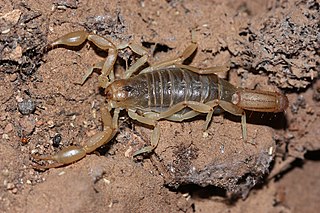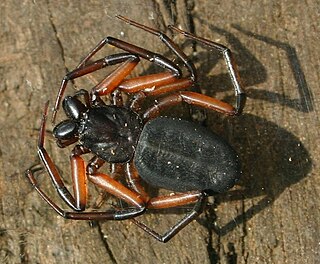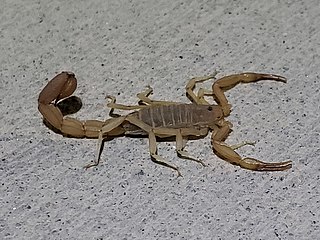
Scorpions are predatory arachnids of the order Scorpiones. They have eight legs and are easily recognized by a pair of grasping pincers and a narrow, segmented tail, often carried in a characteristic forward curve over the back and always ending with a stinger. The evolutionary history of scorpions goes back 435 million years. They mainly live in deserts but have adapted to a wide range of environmental conditions, and can be found on all continents except Antarctica. There are over 2,500 described species, with 22 extant (living) families recognized to date. Their taxonomy is being revised to account for 21st-century genomic studies.

Amblypygi is an order of arachnids also known as whip spiders or tailless whip scorpions, not to be confused with whip scorpions or vinegaroons that belong to the related order Thelyphonida. The name "amblypygid" means "blunt tail", a reference to a lack of the flagellum that is otherwise seen in whip scorpions. Amblypygids possess no silk glands or venom. They rarely bite if threatened but can grab fingers with their pedipalps, resulting in thornlike puncture injuries.

Paravaejovis spinigerus, commonly known as the stripe-tailed scorpion or devil scorpion, is a species of scorpion in the family Vaejovidae. It is found in the south-western United States and north-western Mexico.

Gigantometrus swammerdami, commonly called the giant forest scorpion, is a scorpion belonging to the family Scorpionidae. It is native to India and is the world's largest scorpion species at 23 cm in length, and weighs 56 g (2.0 oz).

Platyoides is a genus of spiders belonging to the family Trochanteriidae. Its members are known as scorpion spiders and are found in sub-Saharan Africa and its islands, Madagascar, Réunion, Aldabra and the Canary Islands.

Heterometrus, whose members are also known by the collective vernacular name Asian Forest Scorpion, is a genus of scorpions belonging to the family Scorpionidae. It is distributed widely across tropical and subtropical southeastern Asia, including Indonesia, Brunei, Malaysia, Myanmar, Philippines, Singapore, Cambodia, Laos, Thailand, Vietnam, India, and China (Hainan). It is notable for containing some of the largest living species of scorpions.

Vaejovidae is a family of scorpions, currently comprising 25 genera and over 230 species, found in North America. The species of the family are found from western Guatemala, throughout Mexico, and in the United States, mostly west of the 100° meridian and one species in the Appalachian Mountains. Small, montane species of the genus Vaejovis have been found in pine and spruce forests at elevations over 9,500 feet in New Mexico and Arizona. The northern scorpion, Paruroctonus boreus, is found from northern Arizona to the southern plains of Saskatchewan, Alberta, and British Columbia in Canada and is the northernmost known species of scorpion in the world.

Vietbocap thienduongensis is a species of scorpion in the family Pseudochactidae. This species was described by Phạm Đình Sắc and Wilson Lourenço inside Thiên Đường Cave, a cave located in Phong Nha-Kẻ Bàng National Park, Quảng Bình Province, Vietnam.

Scorpionidae is a family of burrowing scorpions or pale-legged scorpions in the superfamily Scorpionoidea. The family was established by Pierre André Latreille, 1802.

Urodacus is a genus of scorpion belonging to the family Urodacidae. It was described by German naturalist Wilhelm Peters in 1861. The type species is U. novaehollandiae. Its species are native to Australia, and dig burrows. The genus was placed in its own family in 2000. Before this, the group had been a subfamily Urodacinae within the family Scorpionidae. There are likely many undescribed, cryptic species within the genus.
Sahyadrimetrus kanarensis is a scorpion species found in Karnataka, India. It is mostly found in the Western Ghats, which is a biodiversity hotspot and a World Heritage Site. It is an endangered species with habitat destruction as the reason for its dwindling numbers.
Typhlochactidae is a family of troglomorphic scorpions native to eastern Mexico.

The Pseudochactidae are a scorpion family. They are predominantly found in caves.

Vietbocap is a genus of troglobiontic scorpions in the family Pseudochactidae native to South-East Asia.

Stenochrus portoricensis is a species of arachnid belonging to the family Hubbardiidae in the order Schizomida, which are commonly known as short-tailed whip scorpions. They are mostly found in North and Central America, but their parthenogenetic lifestyle allows them to live in other parts of the world in temperate climates. They are able to thrive in different parts of the world, especially in caves, forests, fallen logs, and abandoned nests of termites.

Paravaejovis is a genus of scorpions in the family Vaejovidae. There are about 11 described species in the genus Paravaejovis.

Maaykuyak is a genus of scorpions in the family Vaejovidae, found in Mexico and the United States (Texas).
Srilankametrus yaleensis is a species of scorpion in the family Scorpionidae endemic to Sri Lanka.
Pseudochactas is a genus of scorpions within the family Pseudochactidae, first described by Alexander V. Gromov in 1998. This genus is notable for its distinctive morphological features and its status as a "living fossil" due to its unique evolutionary lineage.
Troglokhammouanus is a monotypic genus of scorpions in the family Pseudochactidae, containing the single species Troglokhammouanus steineri. This genus was first described by Wilson R. Lourenço in 2007 based on specimens collected from the Tham Xe Bangfai cave in Khammouane Province, Laos.












